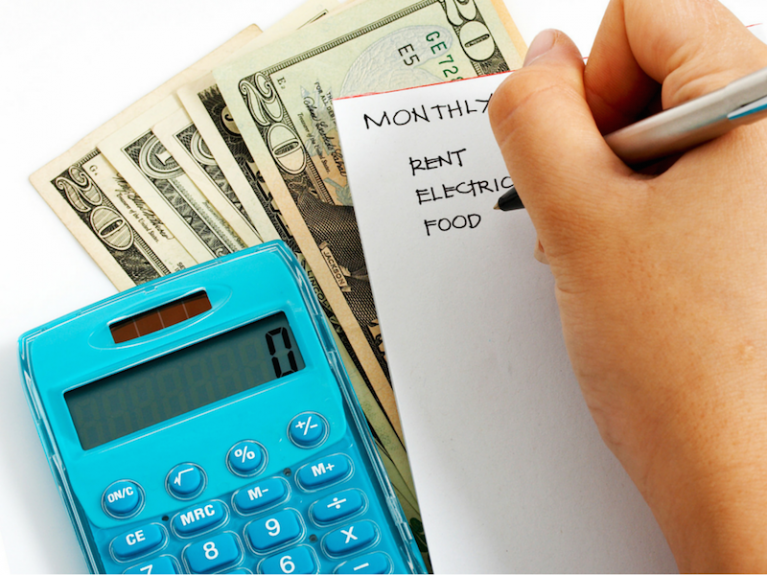Budgeting is one of those things that we all know we SHOULD do, but somehow never find the time (or, let’s be honest, the motivation) for.
Well, we’re here to give you a bit of a kick up the bum, because budgeting can be a really powerful tool to monitor your finances and help you achieve your goals.
Knowing how much you have coming in and going out each month is key to making informed spending decisions and seeing those savings grow.
The good news is it doesn’t have to be as complicated as you think. That’s why we’ve put together this list of steps to take the stress and confusion out of budgeting. Now you have no excuse to keep putting it off.
1. Start with the basics – income and expenses
It should come as no surprise that in order to save money, you need to spend less than you earn. To start with, you need to get a snapshot of your current finances.
You’ll need:
- All of your bills (for the last year, if possible) including utilities, insurance, loan/interest payments, car costs, etc.
- Copies of your last 2 or 3 bank statements and credit/debit card transaction lists
- If you’re the kind of person who hoards receipts, they have finally come in useful – go and get them.
Find a way to record all these numbers that you feel comfortable with. If you’re an Excel whizz, go ahead and create a fancy spreadsheet. If you’re more of a pen and paper kind of person, that’s fine too. And there are tons of apps and online tools that will help you out.
Work out your income and expenses for a period that makes sense to you – probably a calendar month or your pay cycle.
Some things, like electricity bills, don’t come in even monthly payments, so look at how much you spent over the last year and divide by 12 to get your monthly amount. The same goes for anything you pay annually, like insurance.
Try and be honest about the amount you spend on leisure and shopping (it’s probably more than you think). Taking a careful look at your receipts and statements will help you get an accurate picture. Don’t forget things like Christmas and birthday presents, beauty treatments, and online subscriptions. Then add a little bit more just in case.
On the income side, you’ll have your salary, any government assistance you receive, plus income from any dividends or investments.
Once you think you’ve accounted for everything, take a deep breath and subtract your expenses from your income.
If the number is greater than 0, you’re off to a good start and can move on to the next step.
If there’s more going out than coming in, you need to take a pretty urgent look at your spending. Review the list you’ve just made and identify some areas you can cut back on or eliminate altogether (when was the last time you ACTUALLY went to the gym?). Once you’re back in the black, you can think about saving.
2. Give yourself some savings goals
There’s no point going through all that hassle of making a budget if you don’t change anything as a result.
Work out some short, medium and long-term financial targets, then look at how much you need to save each month in order to achieve them.
Don’t stretch yourself to the limit, because you’re less likely to stick at it if it feels like a hardship, but do try to eliminate some unnecessary spending so you have more to put aside each month.
By setting yourself concrete goals, you’re much more likely to stick to your plan and avoid the temptation to overspend. Setting mini-goals, like having enough left at the end of the month to treat yourself to a manicure or a night at the movies, will help to keep you motivated too.
3. Out of sight, out of mind
One of the worst things you can do is to try to keep your savings allocation in your bank account all month long. Every time you go to the ATM it will be staring you in the face, and unless you have superhuman willpower, you’ll find it all too easy to dip into it.
Instead, find yourself a good deal on a high-interest savings account and set up an automatic transfer so your savings allocation leaves your current account AS SOON AS YOU’VE BEEN PAID. You’ll find it much harder to miss what was never there in the first place.
If your bank allows it, and if there are no monthly fees, it might be worth setting up two or three savings accounts – one for each thing you’re saving for – so you can see exactly how far you’ve come towards each of your goals.
4. Factor in an emergency fund
There are some things that you just can’t plan for, like a broken washing machine or a car repair bill. But that doesn’t mean you can’t budget for them.
When you’re creating your budget, factor in an emergency reserve to give you the peace of mind that if something goes wrong, you won’t have to add to the problem with financial worries.
The amount that you set aside depends on your circumstances. If you don’t own a car then it’s unlikely you’ll have a repair bill coming your way. But think about all the things that COULD happen and try to keep enough money to cover a couple of them (or three, if you’re superstitious).
The reality of budgeting
Once you’ve set up your budget, you might want to monitor your spending quite closely for the first couple of months to make sure you haven’t wildly overestimated or underestimated any parts of it.
After you’ve made any necessary adjustments, you’re probably safe to take a step back and just check monthly to make sure you’re on track. If things just aren’t adding up, then take a closer look again.
Most importantly, remember to enjoy the freedom that you get from being in control of your finances.











